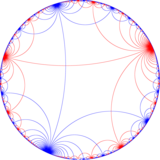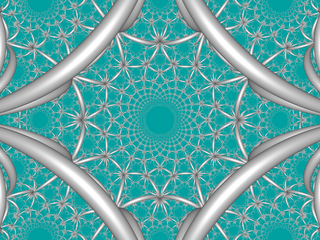Two dimensional compounds
For any natural number n, there are n-pointed star regular polygonal stars with Schläfli symbols {n/m} for all m such that m < n/2 (strictly speaking {n/m}={n/(n−m)}) and m and n are coprime. When m and n are not coprime, the star polygon obtained will be a regular polygon with n/m sides. A new figure is obtained by rotating these regular n/m-gons one vertex to the left on the original polygon until the number of vertices rotated equals n/m minus one, and combining these figures. An extreme case of this is where n/m is 2, producing a figure consisting of n/2 straight line segments; this is called a degenerate star polygon.
In other cases where n and m have a common factor, a star polygon for a lower n is obtained, and rotated versions can be combined. These figures are called star figures, improper star polygons or compound polygons. The same notation {n/m} is often used for them, although authorities such as Grünbaum (1994) regard (with some justification) the form k{n} as being more correct, where usually k = m.
A further complication comes when we compound two or more star polygons, as for example two pentagrams, differing by a rotation of 36°, inscribed in a decagon. This is correctly written in the form k{n/m}, as 2{5/2}, rather than the commonly used {10/4}.
Coxeter's extended notation for compounds is of the form c{m,n,...}[d{p,q,...}]e{s,t,...}, indicating that d distinct {p,q,...}'s together cover the vertices of {m,n,...} c times and the facets of {s,t,...} e times. If no regular {m,n,...} exists, the first part of the notation is removed, leaving [d{p,q,...}]e{s,t,...}; the opposite holds if no regular {s,t,...} exists. The dual of c{m,n,...}[d{p,q,...}]e{s,t,...} is e{t,s,...}[d{q,p,...}]c{n,m,...}. If c or e are 1, they may be omitted. For compound polygons, this notation reduces to {nk}[k{n/m}]{nk}: for example, the hexagram may be written thus as {6}[2{3}]{6}.
 2{2} | 3{2} |  4{2} | 5{2} |  6{2} | 7{2} |  8{2} | 9{2} |  10{2} |  11{2} |  12{2} |  13{2} |  14{2} |  15{2} | |
| 2{3} |  3{3} |  4{3} |  5{3} | 6{3} |  7{3} |  8{3} |  9{3} |  10{3} |  2{4} |  3{4} |  4{4} |  5{4} |  6{4} |  7{4} |
| 2{5} |  3{5} |  4{5} |  5{5} |  6{5} | 2{5/2} |  3{5/2} |  4{5/2} |  5{5/2} |  6{5/2} |  2{6} | 3{6} |  4{6} |  5{6} | |
| 2{7} |  3{7} |  4{7} | 2{7/2} |  3{7/2} |  4{7/2} | 2{7/3} |  3{7/3} |  4{7/3} |  2{8} |  3{8} |  2{8/3} |  3{8/3} | ||
| 2{9} |  3{9} | 2{9/2} |  3{9/2} | 2{9/4} |  3{9/4} |  2{10} |  3{10} |  2{10/3} |  3{10/3} | |||||
 2{11} |  2{11/2} |  2{11/3} |  2{11/4} |  2{11/5} |  2{12} |  2{12/5} |  2{13} |  2{13/2} |  2{13/3} |  2{13/4} |  2{13/5} |  2{13/6} | ||
 2{14} |  2{14/3} |  2{14/5} |  2{15} |  2{15/2} |  2{15/4} |  2{15/7} |
Regular skew polygons also create compounds, seen in the edges of prismatic compound of antiprisms, for instance:
| Compound skew squares | Compound skew hexagons | Compound skew decagons | |
| Two {2}#{ } | Three {2}#{ } | Two {3}#{ } | Two {5/3}#{ } |
 |  |  |  |































